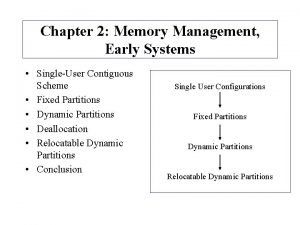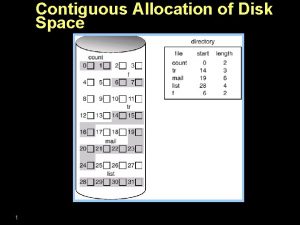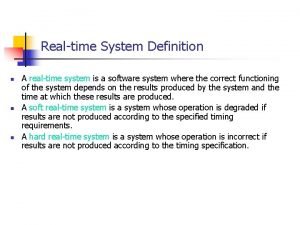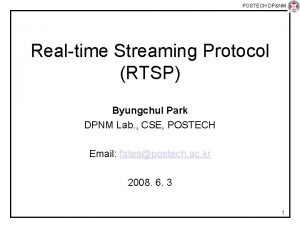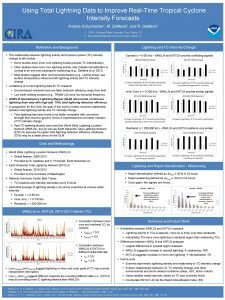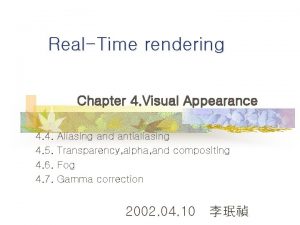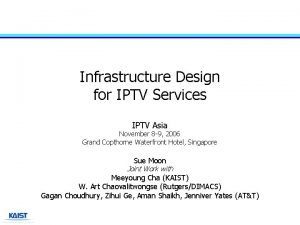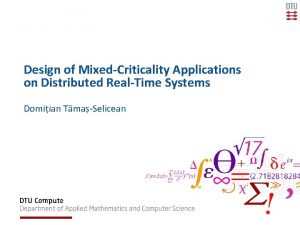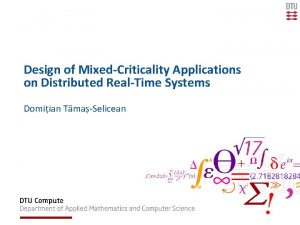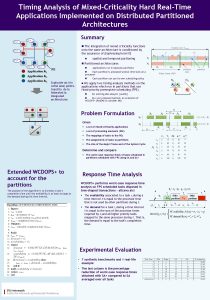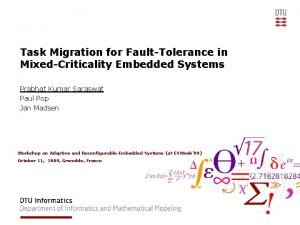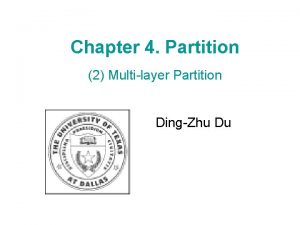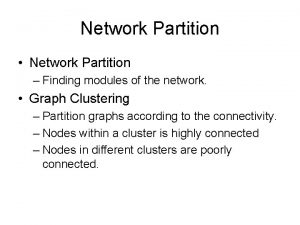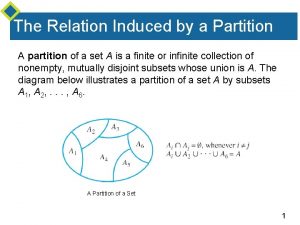Task Mapping and Partition Allocation for MixedCriticality RealTime





















- Slides: 21

Task Mapping and Partition Allocation for Mixed-Criticality Real-Time Systems Domițian Tămaș-Selicean and Paul Pop Technical University of Denmark

Motivation § Safety is the property of a system that will not endanger human life or the environment § A safety-related system needs to be certified § A Safety Integrity Level (SIL) is assigned to each safety related function, depending on the required level of risk reduction § There are 4 SILs: § SIL 4 (most critical) § SIL 1 (least critical) § SIL 0 (non-critical) – not covered by standards § SILs dictate the development process and certification procedures 3

Motivation § Real time applications implemented using distributed systems Federated Architecture SIL 3 SIL 4 § Mixed-criticality applications share the same architecture Integrated Architecture SIL 1 SIL 3 SIL 2 SIL 4 SIL 1 Application A 1 PE Application A 2 Application A 3 Solution: partitioned architecture 4

System Model § Partition = virtual dedicated machine § Partitioned architecture § Spatial partitioning § protects one application’s memory and access to resources from another application § Temporal partitioning § partitions the CPU time among applications 5

System Model PE 2 PE 1 PE 2 PE 3 Partition slice Major Frame § Temporal partitioning g n ppi a m ns § Static partitionasktable o e t artiti z i § Repeated tim with f p period MF p o o : on §ob. Partition overhead lem locatiswitch l r P nd a § a. Each partition can have its own scheduling policy § A partition has a certain SIL 6

Application Model § Static Cyclic Scheduling 7

Problem formulation § Given § § A set of applications The criticality level (or SIL) for each task A set of N processing elements (PEs) The size of the Major Frame and of the Application Cycle § Determine § § The mapping of tasks to PEs The sequence and length of partition slices on each processor The assignment of tasks to partitions The schedule for all the tasks in the system § Such that § All applications meet their deadline 8

Motivational Example 9

Motivational Example 10

Motivational Example 11

Optimization Strategy § Mapping and Time-Partitioning Optimization (MTPO) strategy: § Tabu Search meta-heuristic § The mapping of tasks to processors § The sequence and length of partition slices on each PE § The assignment of tasks to partitions § List scheduling § The schedule for the applications § Tabu Search § Minimizes the cost function § Explores the solution space using design transformations 12

Optimization Strategy § Degree of schedulability § Captures the difference between the worst-case response time and the deadline § Cost Function 13

Optimization Strategy: Design Transformations 14

Optimization Strategy: Design Transformations 15

Optimization Strategy: Design Transformations 16

Optimization Strategy: Design Transformations 17

Optimization Strategy: Design Transformations § Task re-assignment 18

Experimental Results § Benchmarks § 5 synthetic § 3 real life test cases from E 3 S § MTPO compared to: § MO+TPO § Optimization where first we do a mapping optimization, without considering partitioning (MO), and then we perform a partitioning optimization, considering the mapping obtained previously as fixed (TPO) 19

Experimental Results 20

Conclusions § Mixed-criticality systems, with applications of different criticalities running on the same processors, are implemented using a partitioned architecture. § Optimizing the time partitions and the task allocation to partitions leads to schedulable solutions with improved resource utilization. § We proposed a Tabu Search based optimization algorithm. 21

Thank you! Domit ian Ta mas -Selicean dota@imm. dtu. dk 22
 Paged segmentation
Paged segmentation Single contiguous memory management
Single contiguous memory management Linked allocation
Linked allocation Memory parameters
Memory parameters Forward mapping vs backward mapping
Forward mapping vs backward mapping Transform mapping dan transaction mapping
Transform mapping dan transaction mapping Tiered task bias task
Tiered task bias task Simple online and realtime tracking
Simple online and realtime tracking The definition of a real-time system.
The definition of a real-time system. Realtime aps software
Realtime aps software Firebase realtime database push notification
Firebase realtime database push notification Realtime streaming protocol
Realtime streaming protocol Halthywa
Halthywa The forrester wavetm real-time interaction management
The forrester wavetm real-time interaction management Lightning realtime
Lightning realtime Rendering realtime compositing
Rendering realtime compositing Real time characteristics of embedded operating systems
Real time characteristics of embedded operating systems Realtime communications
Realtime communications Realtime it
Realtime it Realtime it
Realtime it Realtime it
Realtime it Asiaplus realtime
Asiaplus realtime

